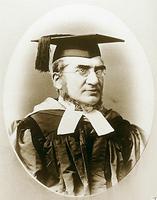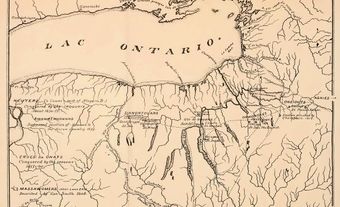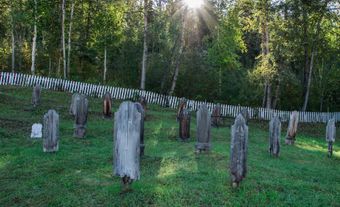Judaism is the religion of the Jewish people. Its origins were in ancient Israel, where the sacred text of the Hebrew Bible was understood to be God's revelation. The Bible's core is the Torah-the 5 books delivered by God to the Jewish people at Mount Sinai through their liberator, teacher and prophet Moses. The other sections of the Bible- the books of the prophets, histories and ethical works-are based on the centrality of the Torah.

Judaism
In the centuries following the destruction of the Temple in Jerusalem in 70 AD during the unsuccessful struggle for independence from the Roman Empire, the rabbis, the religious teachers of the Jews, compiled additional sacred texts-the Mishnah, and the Palestinian and Babylonian Talmuds. Later rabbis added more commentaries and legal codes. The rabbis taught that Mishnah and Talmud were "oral Torah"-given to Moses at Sinai, but only written down when their oral transmission was jeopardized by the destruction of the Temple.
The original "written Torah," the later texts of the "oral Torah," and other sacred writings served as "a portable homeland," a comprehensive text-based holy way of life which would preserve the Jewish people and their faith in their period of exile. The rabbi's role in this way of life was to be a legal scholar, whose knowledge of the law would guide daily life. Judaism was understood to be about much more than prayer, synagogue, fasts and festivals. The Judaism based on the written and oral Torah also concerned itself with family, business, civil and criminal law; the court system by which these were legislated and enforced; and the philosophies and world-views which gave meaning to the presence of the Jews in history. Thus Judaism developed as a framework for religion, society and culture.
Biblical Judaism developed as a challenge to traditional pagan beliefs and practices. Christianity and Islam self-consciously developed as successor religions to Judaism. While revering Judaism as the original revelation, they have also portrayed Judaism as the religion rejected by their later revelations. Bizarre, hostile portraits of Judaism have been accompanied by humiliation, expulsion and violence. The vilification of Judaism has been present in Canadian society, but has diminished as a broad consensus on religious tolerance and pluralism has become part of Canadian culture. The National Council of Christians and Jews provides a framework for promoting religious tolerance and Jewish-Christian dialogue. There are tentative movements towards a Jewish-Moslem dialogue. (See also Anti-Semitism; Prejudice and Discrimination.)
While the United States maintained the separation of church and state since its founding, Canada's founding arrangements recognized Catholic and Protestant group rights. Members of minority religions, however, could become full citizens. With the exception of the important area of education, where some provinces give full public support to confessionally based Christian schools systems while equivalent support is not available to non-Christian schools, religious minorities in Canada now enjoy the rights and privileges of all Canadians. This degree of equal status under the law is far beyond the experience of Jews before the 19th century.
The opportunity to participate as equals in an open society has been a challenge to Jews and Judaism. An open, competitive economy gave immigrants a chance to work their way out of poverty. It also encouraged deviation from ritual prohibitions which limit economic opportunity, such as the prohibition against working on Saturday and other Jewish holy days. Mandatory education placed Jewish children in public schools which intentionally aimed to transform them into good Canadians, where children of immigrants studied science, history and literature unknown to previous generations of Jews. Most who went on to higher education were impressed by the cosmopolitan culture of western intellectuals. As participants in a developing consumer society, Canadian Jews were encouraged to devote their leisure hours to shopping and entertainment rather than the pious communal activities mandated by their tradition. In response to these challenges, a few Jews took the route of an abrupt break with Judaism. The more common response was to combine some degree of fidelity to Judaism, the comfort of traditionally based family and communal ties, and the drive for acceptance and integration into Canadian society.
Demography
Jews are mainly urban, concentrated in the 3 large metropolitan centres. The largest number are in Ontario, especially Toronto. Montréal, where the first Canadian synagogue was established and which was for many years the largest Canadian Jewish community, remains a centre of Jewish life. Vancouver's Jewish population has been growing. In religious affiliation and practice, the Jewish community of Montréal is the most traditional, while that of Vancouver is the least.
The Canadian census counts Jews as both an "ethnic group" and a "religion." In the 1991 census, approximately 318 000 Canadians reported their religion as Jewish. Jewish organizations estimate a total Jewish population of about 356 000, including those who reported themselves on the 1996 census as Jews by ethnic group but with "no religion." Most of the minority who report themselves as belonging to the Jewish "ethnic group" but having "no religion" are not completely separated from religious knowledge and observance. Because of the close relationship between religion and other aspects of Jewish identity, they usually have some religious education, participate in events which blend religious observance with extended family ties, and observe, in their own ways, Jewish life-cycle events.
Branches of Judaism
The branches of Judaism that have developed as a response to the new place of Jews in modern society are all represented in Canada. Orthodox Judaism, which maintains the divinely revealed character of both written and oral Torah, requires adherence to a highly distinctive way of life. Conservative Judaism, which developed in the United States at the Jewish Theological Seminary, interprets Torah in a more flexible way, allowing its adherents to share in Canadian social, cultural and educational institutions while professing complete continuity with an ever-evolving tradition. Reform Judaism, while respecting traditional sources of wisdom and inspiration, explicitly rejects the divine revelation of the oral law. Reform Jews observe practices such as the dietary laws or Sabbath restrictions only on an optional basis.
Early Jewish immigrants to Canada came mostly from places where only Orthodox Judaism was practised. Almost all Canadian synagogues whose origins go back to the turn of the century were founded as Orthodox. Holocaust survivors who immigrated to Canada included Hasidim, Orthodox Jews whose study of mystical texts is combined with a high degree of separation from outside cultural influence, who successfully established communities in Montréal and Toronto. North African Jews who immigrated in the 1950s established Orthodox synagogues, mainly in Montréal, with a few in Toronto. At present, Orthodox congregations remain numerous. The orientation of Canadian synagogues towards Conservative Judaism was gradual, often taking place in the second or third generation after immigration. Canadian Jews are now most likely to be affiliated with Conservative synagogues. The Reform movement was limited until the early 1950s to 3 congregations in Canada, but has also grown considerably and is well established as a major branch of Canadian Judaism. A few synagogues belonging to the smaller Reconstructionist movement, which is based on the concept of a Jewish religious civilization, are also found in Canada.
Institutions
In their personal lives, Canadian Jews are less involved with the theological differences between the branches of Judaism than with the synagogues and schools which are the foundations on which the branches of Judaism rest. Synagogues are the property of the congregation. Congregations choose the branch of Judaism with which to affiliate and normally choose a rabbi from the rabbinical seminary of that branch. Affiliation fluctuates with the life cycle; it is most common when children are in primary school. In larger cities, congregations compete for members. The rabbi's role has become less legal and more pastoral, shaped by a population used to "shopping around," who are sometimes seeking spiritual bearings in a dangerous and complex world and sometimes seeking only a pleasant setting for life-cycle rituals and socially required infrequent appearances.Jewish schools rival synagogues as centres of religious activity. Almost all Jewish schools are under religious sponsorship; the large majority of Jewish children will receive at least a few years of Jewish education. Jewish schools are of 2 types-schools which meet for several hours a week outside of public school hours and schools which students attend in place of public schools. The schools which complement public school are almost always sponsored by congregations. In the past generation, private Jewish alternatives to public school, called "day schools," have grown considerably. Day schools follow a double curriculum, typically with half the day spent on the provincially mandated curriculum and half the day spent on Judaica. Judaica includes text study-Bible, and in some places Talmud-Hebrew language, Jewish history and religious practices. Orthodox Zionist, Orthodox non-Zionist, Conservative and Sephardic (teaching the religious and cultural traditions of the Jews from North Africa) day schools are found in both Montréal and Toronto; in Toronto, Reform and Labour Zionist day schools are also available; Montréal maintains a day school founded as a Yiddishist school, which teaches French, English, Hebrew and Yiddish. In smaller communities, such a broad choice is not available.
The Orthodox are represented in Jewish education in numbers far beyond their proportion in the community because Orthodox Jews require a detailed knowledge of ritual, place a stronger value on the study of Jewish texts, are more willing to sustain many years of private school tuition, and have less difficulty with separation from Canadian culture. On the other hand, Judaism is taught in the secular Zionist and Yiddishist schools. Students educated in these schools will be in settings where Judaism is practised, and Judaism, as a historic framework of Jewish life, is part of their cultural background.
After high school, there is considerable opportunity for part-time religious study; some continue full-time study of Talmud and other texts in Orthodox yeshivot. Jewish Studies has entered the university curriculum at McGill University, Concordia University, York University, the University of Toronto and the University of British Columbia.
Ritual Practices
The branches of Judaism differ in their standards for distinctive ritual practices. Most Jews are selective in their practices, not strictly adhering to the standards of the branch with which they identify. Common practices are family seders on the first 2 nights of Passover, which commemorates the liberation from slavery in Egypt; synagogue attendance on the New Year (Rosh Hashanah) and Day of Atonement (Yom Kippur), along with fasting on the latter; lighting candles on Friday night before a family meal; and candle lighting on Hanukkah, which commemorates the successful Jewish revolt against the Seleucid Empire in the 2nd century BC.
Commonly observed life-cycle practices are ritual circumcision at 8 days, marking the entry into the covenant between Jews and God; celebration of a child's 13th birthday with a synagogue bar mitzvah for boys and bat mitzvah for girls; weddings with a rabbi officiating; and religious funerals followed by internment in a Jewish cemetery.
Even though traditional practices which impinge upon participation in Canadian life have been abandoned by most, Canada's Jews wish to invest their identity with transcendent meaning. Most contemporary Jewish practice stresses the importance of family and people. With an increasing number of Jews marrying spouses born outside the faith, study of Judaism for the purpose of conversion has become much more common; conversion involves joining family, community and people as well as the religion. A significant minority of Canadian Jews retain high levels of ritual practice out of choice, indicating the power of Judaism to answer questions of meaning and morality and to meet the needs for a supportive community and transcendent experiences.
Judaism and Peoplehood
Attachment to the Jewish people has a religious dimension. In Judaism the people, as a group, carry the sacred message. The Holocaust and the establishment of the state of Israel are powerful symbols to Canadian Jews. A mythic Israel (not entirely identified with the political state) appears as a phoenix rising out of the ashes of Auschwitz, the symbol of ultimate evil. These events function as sacred stories, endowing Jewish peoplehood with transcendent meaning.
Judaism and Community
Members of synagogues are almost always members of other Jewish organizations, some religious, some not. The Talmud says, "All Jews are responsible for each other." Even among Jews who are unaffiliated or who consider themselves secular, responsibility to the Jewish people is felt as a moral obligation.
The specifically religious institutions of Canadian Jews are integrated into the broader community. Congregations are members of the Canadian Jewish Congress and of the Jewish federations found in local communities across Canada. Jewish federations raise funds on behalf of homes for the aged, social work agencies and other Jewish social welfare services. These agencies work co-operatively with the religious institutions of Canadian Jews. Federations also raise funds for Jewish education, sometimes devoting a large part of the local budget to this responsibility.
Judaism and Zionism
Just as peoplehood and religious commitment are intertwined, the Zionist movement has a religious dimension. Zionism had strongly secular beginnings, rejecting the teaching that only prayer and moral purification would lead to the end of Jewish exile. The movement, however, was supported by a great many Jews who followed traditional Jewish rituals and were members of synagogues. Zionism's pragmatic call for a place of refuge for persecuted Jews and the promise in the Torah that the Jews would be a free people in the land of Israel were powerful incentives. The Zionist movement had a strong popular following among Canadian Jews from the time of its organization in the late 19th century.
Currently, each branch of Judaism sponsors its own Zionist organization, which promotes ties to Israel within the branch and the interests of the branch within the Zionist movement. The Conservative and Reform Zionist organizations support the development of their movements in Israel by encouraging philanthropy, travel, study and aliyah (moving to Israel) within their own frameworks. Canadian Conservative and Reform Zionist organizations also join in the lobby to modify the imposition of Orthodox standards on the Israeli public and the considerable state support in Israel which is available only to Orthodox institutions. Orthodox Zionism has been particularly effective at creating links between Canadian Jews and Orthodox institutions in Israel. Orthodox Jews are more likely than other Canadian Jews to travel to Israel, send their children to study and to make aliyah themselves. A minority within Orthodox Judaism object to the national obligations which accompany Zionism; they work co-operatively with their counterparts-the non-Zionist Orthodox Jews who live in Israel.
Judaism and Social Movements
Canadian Jews, like American Jews, have been well represented in social movements to ameliorate the suffering of the poor and oppressed. This activity can be seen as growing out of the Jewish religious heritage, with its prophetic vision of justice and universal peace.
In sum, the dynamics of Canadian Judaism lie in the tension between the commitment to participation in Canadian life and the commitment to retention of Jewish identity. The strategies used to balance these two commitments vary, leading to a community which is ideologically pluralistic but socially integrated. Canadian Jews interpret the heritage of Judaism in different ways, yet they share a common life and expect to share a common future.
See also Jewish writing.

 Share on Facebook
Share on Facebook Share on X
Share on X Share by Email
Share by Email Share on Google Classroom
Share on Google Classroom


